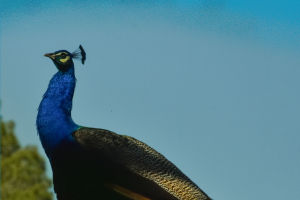Woodpeckers are known for hunting insects in bark and burrowing in dead wood for their nests. Except for Australia and New Guinea, it is almost all over the world, with the largest number in South America and Southeast Asia.
Most woodpeckers are resident birds, but a few temperate species such as the North American yellow-bellied sap-sucking woodpecker and the fluttering beetle have migratory habits. This article will introduce you to the following types of fascinating woodpeckers.
1. The witty oak woodpecker
Most woodpeckers bang on tree trunks in order to kill pests or build a new nest. But the oak woodpecker, which is widespread in the western United States, Mexico, and Central America, is a notable exception.
This bird has wide eyes and gorgeous feathers, just like a circus clown. With a preference for food storage and companionship, they have a rich social life and naturally slack off at work.
During the breeding season, many birds tend to live alone, while oak woodpeckers live in groups, feeding together and producing offspring together.
In the territory of oak woodpeckers, they peck hundreds of tiny holes in oak trees to store acorns. These flocks of birds guard their oaks, or "granaries," because that's where they live. When food is needed, the acorns are pecked off the tree.
This scene is like an acorn being sifted through a sieve, which is full of bullet-like trunks. Occasionally, the house is also seen as a good storage place by the oak woodpeckers, and the door frames are pecked by them as if they were shot.
2. The regurgitated Geocolaptes olivaceus
Most woodpeckers are named after the trees in which they live, where they hunt, burrow, and build their nests. Geocolaptes olivaceus has ghostly eyes and earth-colored feathers mingled with bright reds that match the colors of rock and soil.
Geocolaptes olivaceus forage on the ground, not in trees. The bird is only found in South Africa, Swaziland, and Lesotho, and usually inhabits barren hilly areas with steep slopes, grass, and gravel. The largest woodpecker in these areas, Geocolaptes olivaceus can grow to 30 cm (1 ft).
In search of a special delicacy, a type of ant, they carefully scour rocks and open areas. Geocolaptes olives also eat termites and other insects, although this ant is already enough to provide them with plenty of food. Their long, retractable, mucus-filled tongues can pick up tiny targets and pull out hidden insects.
Geocolaptes olivaceus work together as males and females, digging tunnels with their powerful beaks, making nests in embankments, and laying their eggs in earthen nests. When the eggs are hatched, the male and female Geocolaptes olivaceus regurgitate the previously eaten insects to feed their chicks.
3. Sap-sucking Woodpecker
In North American forests, there are four types of woodpeckers: the Williamson woodpecker, the yellow-bellied woodpecker, the red-necked woodpecker, and the red-breasted sap-sucking woodpecker.
Sap-sucking woodpeckers drill holes in certain trees to suck the sap and prey on small insects that are attracted to the sap. These woodpeckers maintain a good cooperative and mutually beneficial relationship with hummingbirds. Hummingbirds follow sap-sucking woodpeckers in foraging for food on the trees they burrow to suck the sap.
For sap-sucking woodpeckers, hummingbirds drive away larger birds that covet the sap, leaving food for themselves. While many birds salivate for the sap, they don't have the right beaks to burrow on their own.
Hummingbirds depend on the nutrients in nectar to survive. However, as they migrate north in the spring, cold weather can delay flowering, causing a shortage of nutrients the hummingbirds need. And because sap is similar in composition to nectar, the sap is an excellent substitute for nectar.
Like nectar, the sap is nutritious and contains a lot of sugars, minerals, and amino acids. Sap-sucking woodpeckers burrow only in the spring and summer, and when the sap dries up, they eat insects, nuts, and fruit to satisfy their hunger.
4. Insect eater
During the first expeditions to explore the American West, led by Lewis and Clark in the early 19th century, a black, flashing, striking Lewis' woodpecker stood out among the woodpeckers. Local residents use pine or oak trees to open up territories and common areas.
Lewis’s woodpeckers have a knack for drilling, but they drill mostly to find a hole to live in, not to eat bugs. Lewis's woodpecker, however, may eat tree insects, but more often sits on dead wood or a pole and watches, then flies out to catch the insects for food. In fall and winter, these woodpeckers eat acorns, fruits, seeds, and other nuts.
America's largest woodpecker is 28 centimeters (11 inches) long, and Lewis's woodpecker is better at flying than other woodpeckers. It has a remarkable gliding ability and can flap its wings more slowly, making it fly more like a sparrow than other woodpeckers.


